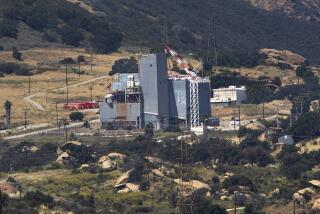Revamp of U.S. Research Labs Urged : Science: Congressman calls for shake-up of facilities to scale back and consolidate nuclear weapons work. He proposes using Livermore for civilian technologies.
CHICAGO — A prominent California congressman called Saturday for a massive restructuring of the Department of Energy’s major research laboratories, including the Lawrence Livermore National Laboratory in Northern California.
George E. Brown Jr. (D-Colton), chairman of the House Committee on Space, Science and Technology, said that all of Livermore’s research on nuclear weaponry and the Strategic Defense Initiative should be transferred to the Los Alamos National Laboratory in New Mexico. Defense-related work at Sandia National Laboratory in Albuquerque should also be transferred to Los Alamos, he said.
In a letter to Secretary of Energy James D. Watkins, released here at a meeting of the American Assn. for the Advancement of Science, Brown argued that Livermore should be restructured as a center for civilian technologies, including materials science, fusion, biotechnology, computational sciences and environmental remediation. Sandia would be devoted to non-nuclear engineering and the application of government technology in private industry.
Brown also called for an end to underground nuclear testing within three years and the creation of a Russian-American Foundation to fund research projects benefiting both countries. Grants from the foundation would put Russian scientists to work so that nuclear and weaponry technology would not spread to the Third World.
Brown’s proposal for the weapons laboratories came in response to the draft report of a task force created by Watkins to develop a “strategic vision” for the laboratories. Brown argued that the task force report is “neither strategic or visionary” because it calls, in effect, for a continuation of business as usual.
Because of the post-Cold War world climate, Brown said, “the nation no longer needs three nuclear weapons labs . . . each funded at approximately $1 billion per year and each with employment of about 8,000 people.” Instead, he said, each should have its own mission.
Over a three-to five-year period, he proposed, all nuclear design, ballistic missile defense and other classified defense activities would be terminated or transferred to Los Alamos, which was the first of the labs to conduct nuclear research.
Livermore would then be devoted entirely to civilian technologies, particularly the so-called critical technologies that are viewed as crucial to economic prosperity.
Some steps have been taken in this direction. Livermore is the focus of the Department of Energy’s participation in the Human Genome Project, which is aimed at deciphering the entire genetic blueprint of humans.
The laboratory is especially involved in the data processing aspects of the project, developing ways to manipulate and communicate the vast amount of information that will be available.
Brown would halt all nuclear weapons testing except for that designed to enhance the safety of the nuclear stockpile. He would reduce the Department of Energy budget for nuclear weapons research, development, testing and evaluation by 20% per year over each of the next four years, thereby freeing more than $2 billion that could be directed toward civilian technology investments.
More to Read
Sign up for Essential California
The most important California stories and recommendations in your inbox every morning.
You may occasionally receive promotional content from the Los Angeles Times.










